Navigating the Tree of Life
Tree of Life pages about organisms (branch pages, leaf pages, articles, notes, and treehouses) contain a variety of navigation elements that help users move between the pages of the website:
- Overview of Navigation Elements
- The Tree Diagram/List of Subgroups
- The Right Sidebar: Explore the Tree of Life
Overview of Navigation Elements
Each ToL page has two main navigation centers:
- The top navigation bar provides links to the ToL home page and the major sections of the ToL documentation, along with a general search field.
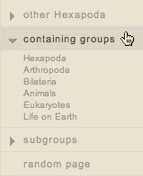 The right
sidebar features links encouraging visitors
to explore other pages about organisms on the ToL web site. Most
of these links are contained in several collapsible
menus, which are closed by default if your browser
is javascript enabled. You
can open them by clicking either on the triangle next to the menu header
or on the menu header itself. In order to close a menu, click on the
header or triangle again. Note that when you open a particular menu on
a page, corresponding menus will remain open on other ToL pages as you
move from page to page. If your browser is not using javascript, the right
sidebar menus will always be open.
The right
sidebar features links encouraging visitors
to explore other pages about organisms on the ToL web site. Most
of these links are contained in several collapsible
menus, which are closed by default if your browser
is javascript enabled. You
can open them by clicking either on the triangle next to the menu header
or on the menu header itself. In order to close a menu, click on the
header or triangle again. Note that when you open a particular menu on
a page, corresponding menus will remain open on other ToL pages as you
move from page to page. If your browser is not using javascript, the right
sidebar menus will always be open.
In addition, ToL branch pages feature a tree diagram or a list of subgroups providing links to the containing group and subgroups of the branch.

ToL pages also have three supplementary navigation features:
- When you move your mouse over one of the section links in the top
navigation bar,
you will get more detailed links to the ToL documentation pages
in that particular section.

- In the top left corner of the content box of each branch and leaf page, you will also find a button
 that lets you access a series of other buttons with links to related groups. Some of these buttons will open menus with several groups to choose from.
that lets you access a series of other buttons with links to related groups. Some of these buttons will open menus with several groups to choose from.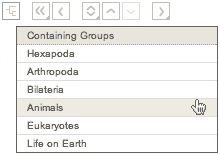
- The bottom navigation bar provides links to the
ToL home page, the privacy and copyright policies, and the major
sections of the ToL documentation.

The Tree Diagram/List of Subgroups

On ToL branch pages, links in the tree diagram or list of subgroups let you move up and down the Tree of Life one step at a time.
Both tree and subgroups list let you move UP the ToL to the page of a subgroup by clicking on the name of the group. Note that only subgroups that are blue have an associated ToL page. When you move your cursor over a blue name and click the mouse, you will be taken to the ToL page of that group.
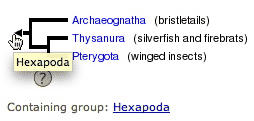
The tree also lets you move DOWN the ToL to the page of the containing group.When you move your cursor over the root of the tree, a tooltip will appear indicating the name of the containing group. Clicking on the root will then take you to the ToL page for the containing group.
In addition, there is always a link to the containing group listed immediately below the tree diagram or list of subgroups.
For more information about tree diagrams and lists of subgroups, please consult the Interpreting the Tree Diagram or List of Subgroups page.
The Right Sidebar: Explore the Tree of Life
The right sidebar of ToL pages about organisms invites users to explore other pages about organisms on the ToL site. The sidebar is divided into two major sections:
Information About the Current Group
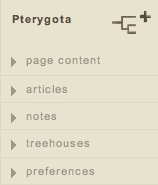
Each ToL branch page, leaf page, article, note, or treehouse provides information about a particular group of organisms. The name of this group is displayed at the top of the right sidebar. On article, note, and treehouse pages, this name also serves as a link to the corresponding branch or leaf page. Below the group name, there is a series of menu providing links to information about this group:
- page content
- This menu provides a table of contents for the current page with links to the different page sections.
- articles
- This menu has links to pages providing in-depth scientific information about this group of organisms. The first item on this list is the branch or leaf page, followed by other articles authored by expert biologists.
- notes
- This menu has links to pages providing brief accounts and commentaries about this group of organisms, collections of media files (e.g., image or movie galleries), taxonomic information, or identification tools authored by expert biologists.
- treehouses
- This menu has links to treehouses, which are ToL pages designed for children or the young at heart. Treehouses may be authored by students, teachers, and other people who are not professional biologists. Entries in this menu are sorted according to six different treehouse categories: investigations, stories, fun and games, art and culture, teacher resources, and biographies
- preferences
- This menu does not have links to pages about organisms; instead, it has links that let you set certain preferences for the display of information on pages about organisms.
Explore Other Groups
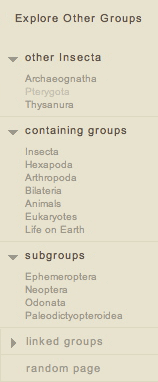
The lower part of the right sidebar provides a collection of links that let visitors explore other groups on the ToL web site:
- other ...
- This menu contains links to all the subgroups of the current group's immediate containing group.
- For example, Pterygota (winged insects) is a subgroup of Insecta (insects). Insecta also contains (i.e., is the containing group of) Archaeognatha (bristletails) and Thysanura (silverfish and firebrats). The first menu in the Explore Other Groups section of pages about Pterygota would therefore be called other Insecta, and it would feature links to the Archaeognatha and Thysanura branch pages, along with a listing of Pterygota (for the sake of providing a complete listing of all the Insecta subgroups).
- containing groups
- This menu contains links to the current group's containing groups. Any group in the Tree of Life has a series of hierarchically nested containing groups, starting with the immediate containing group and going all the way down to the ultimate containing group, Life on Earth.
- For example, on pages about Pterygota (winged insects), the containing groups menu starts with a link to Insecta (insects), which is the immediate containing group of Pterygota. Insecta is a subgroup of Hexapoda, which is the next link on the list; Hexapoda is a subgroup of Arthropoda, which is a subgroup of Bilateria, which is a subgroup of Animals, which is a subgroup of Eukaryotes, which is one of the immediate subgroups of Life on Earth.
- subgroups
- This menu has links to the subgroups of the current group.
- For example, there are four different subgroups of Pterygota (winged insects): Ephemeroptera (mayflies), Neoptera (most insects, including bugs, beetles, wasps, moths, flies, etc.), Odonata (dragonflies and damselflies), and Paleodictyopteroidea (a large group of extinct insects from the Paleozoic.)
- linked groups
- This menu is only present on pages for articles, notes, and treehouses that are attached to several groups in the Tree of Life. The link at the top of the right sidebar represents the primary group of attachment, and all the other groups that are covered on a given page are listed in the linked groups menu.
- random page
- When you click on this link, you will be taken to a page that's randomly selected from all the available ToL branch and leaf pages. This is a great way to discover new organisms.
For more information about the hierarchical relationships between different groups of organisms and the navigational structure of the ToL web site, please see the Structure of the Tree of Life page.
 Go to quick links
Go to quick search
Go to navigation for this section of the ToL site
Go to detailed links for the ToL site
Go to quick links
Go to quick search
Go to navigation for this section of the ToL site
Go to detailed links for the ToL site